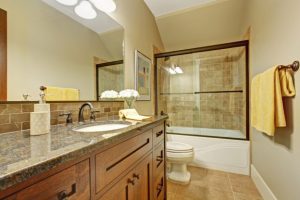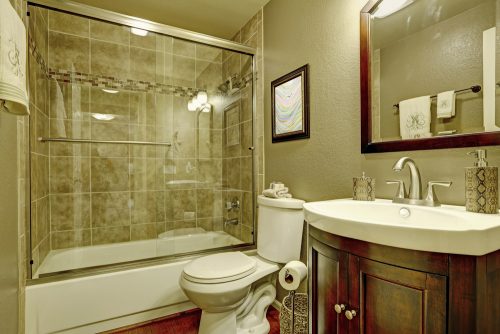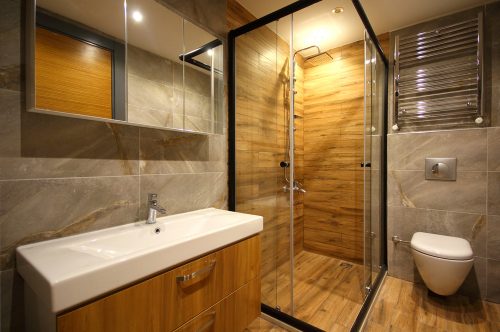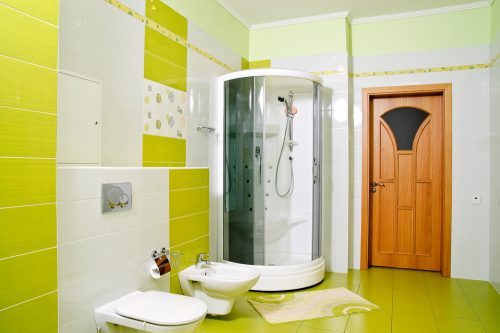Shower and Tub Enclosures for Smaller Bathrooms

A shower or tub enclosure is a structure that opens or closes. They isolate a certain area. They might be of plastic, glass, wood or a different material. So, you could say that they’re similar to screens or the dividing walls in an office.
When people install these enclosures in their bathroom, they’re looking to separate their shower or tub from the surrounding area to keep water from flooding the entire floor. They’re a modern, elegant solution that goes a step beyond the plastic shower curtain.
However, if you have a small bathroom, it’s not easy to choose the right enclosure to make the most of your limited space. So below, we’ll explain some aspects to consider when you’re deciding which to choose and we’ll fill you in on the most popular ones as well.
What to consider when choosing your shower or tub enclosure

Because these enclosures are solid structures that don’t have folds, they’re much more hygienic than shower curtains. While it’s impossible to prevent humidity from forming in the bathroom, cleaning is much easier when you’re dealing with walls.
One thing that makes it easier to clean is the cleaning products and the additional treatments available. Glass and plastic are the most common types of enclosure materials not because of their features, but because they’re affordable.
By using cleaning products and washing away the grime, mold and other contaminants will slide off easily and won’t build up on the enclosure walls.
Aside from the cleaning, other things to consider when choosing a shower enclosure are:
- How the material stands up to humidity, corrosion, impact, and breaks.
- Functionality – the opening and closing system.
- After-purchase service – the warranty duration.
- Additional features. In the case of glass enclosures, the glass might already be tempered or toughened. Different materials, however, might include an anti-calc treatment to prevent build-up.
Glass for smaller spaces
If you have a small bathroom, installing a glass enclosure is your best option because glass is a material that will allow you to see the entire space easily. Because glass doesn’t create any visual barriers, a room can look more spacious and to some degree, more illuminated as well.

Glass can be completely transparent, frosted or screen-printed. The higher degree of intimacy, in addition to being much more attractive, is a big advantage of the latter options. There are three types of glass enclosures to choose from:
- Glass: completely transparent and smooth. It’s elegant and easy to clean.
- Tempered glass: tempered glass is a stronger option and, should the enclosure break, the glass cracks without shattering into sharp pieces that could be dangerous.
- Acrylic glass: this option is actually a translucent plastic material that can be screen-printed. It’s the most economical option on the market.
5 enclosures for small bathrooms
Once you’ve chosen the glass that you want, the next step is to choose the opening and closing system carefully. Keeping in mind that it’s for a smaller space, you really have to choose wisely.
It might not seem relevant, but how the enclosure opens and closes can impact the functionality of your bathroom. For example, if you need to twist and turn in order to exit your shower, you clearly don’t have the right type of enclosure for your bathroom. Below, we’ll show you a variety of enclosures that all have a different way of opening and closing:

- Single wall: a straight structure that consists of one piece. It attaches to the wall and doesn’t move.
- Swinging door: unlike the first option, this door attaches to the wall and moves on a support, opening both inwards and outwards, making for a comfortable entrance or exit.
- Accordion door: this door has two or more sections that fold together to close or expand to open. It’s very convenient for entering and exiting.
- Sliding door: this system has two doors that tuck behind or in front of each other. There are also different combinations of one fixed door and one sliding door for this option. You can alter them easily, so you can have straight or curved sliding doors.
- Rolling door: a rolling door has two parts: the door frame that marks out the space and the drum, which holds a sheet that rolls down.
Now that you’re familiar with the different kinds of enclosure models and the features that each one offers, you can find the best one that suits your bathroom and personal tastes.
A shower or tub enclosure is a structure that opens or closes. They isolate a certain area. They might be of plastic, glass, wood or a different material. So, you could say that they’re similar to screens or the dividing walls in an office.
When people install these enclosures in their bathroom, they’re looking to separate their shower or tub from the surrounding area to keep water from flooding the entire floor. They’re a modern, elegant solution that goes a step beyond the plastic shower curtain.
However, if you have a small bathroom, it’s not easy to choose the right enclosure to make the most of your limited space. So below, we’ll explain some aspects to consider when you’re deciding which to choose and we’ll fill you in on the most popular ones as well.
What to consider when choosing your shower or tub enclosure

Because these enclosures are solid structures that don’t have folds, they’re much more hygienic than shower curtains. While it’s impossible to prevent humidity from forming in the bathroom, cleaning is much easier when you’re dealing with walls.
One thing that makes it easier to clean is the cleaning products and the additional treatments available. Glass and plastic are the most common types of enclosure materials not because of their features, but because they’re affordable.
By using cleaning products and washing away the grime, mold and other contaminants will slide off easily and won’t build up on the enclosure walls.
Aside from the cleaning, other things to consider when choosing a shower enclosure are:
- How the material stands up to humidity, corrosion, impact, and breaks.
- Functionality – the opening and closing system.
- After-purchase service – the warranty duration.
- Additional features. In the case of glass enclosures, the glass might already be tempered or toughened. Different materials, however, might include an anti-calc treatment to prevent build-up.
Glass for smaller spaces
If you have a small bathroom, installing a glass enclosure is your best option because glass is a material that will allow you to see the entire space easily. Because glass doesn’t create any visual barriers, a room can look more spacious and to some degree, more illuminated as well.

Glass can be completely transparent, frosted or screen-printed. The higher degree of intimacy, in addition to being much more attractive, is a big advantage of the latter options. There are three types of glass enclosures to choose from:
- Glass: completely transparent and smooth. It’s elegant and easy to clean.
- Tempered glass: tempered glass is a stronger option and, should the enclosure break, the glass cracks without shattering into sharp pieces that could be dangerous.
- Acrylic glass: this option is actually a translucent plastic material that can be screen-printed. It’s the most economical option on the market.
5 enclosures for small bathrooms
Once you’ve chosen the glass that you want, the next step is to choose the opening and closing system carefully. Keeping in mind that it’s for a smaller space, you really have to choose wisely.
It might not seem relevant, but how the enclosure opens and closes can impact the functionality of your bathroom. For example, if you need to twist and turn in order to exit your shower, you clearly don’t have the right type of enclosure for your bathroom. Below, we’ll show you a variety of enclosures that all have a different way of opening and closing:

- Single wall: a straight structure that consists of one piece. It attaches to the wall and doesn’t move.
- Swinging door: unlike the first option, this door attaches to the wall and moves on a support, opening both inwards and outwards, making for a comfortable entrance or exit.
- Accordion door: this door has two or more sections that fold together to close or expand to open. It’s very convenient for entering and exiting.
- Sliding door: this system has two doors that tuck behind or in front of each other. There are also different combinations of one fixed door and one sliding door for this option. You can alter them easily, so you can have straight or curved sliding doors.
- Rolling door: a rolling door has two parts: the door frame that marks out the space and the drum, which holds a sheet that rolls down.
Now that you’re familiar with the different kinds of enclosure models and the features that each one offers, you can find the best one that suits your bathroom and personal tastes.







